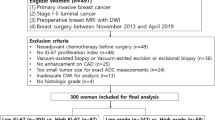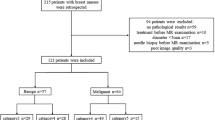Abstract
Purpose
The purpose of this study is to develop a radiomics model for predicting the Ki-67 proliferation index in patients with invasive ductal breast cancer through magnetic resonance imaging (MRI) preoperatively.
Materials and methods
A total of 128 patients who were clinicopathologically diagnosed with invasive ductal breast cancer were recruited. This cohort included 32 negative Ki67 expression (Ki67 proliferation index < 14%) and 96 cases with positive Ki67 expression (Ki67 proliferation index ≥ 14%). All patients had undergone diffusion-weighted imaging (DWI) MRI before surgery on a 3.0T MRI scanner. Radiomics features were extracted from apparent diffusion coefficient (ADC) maps which were obtained by DWI-MRI from patients with invasive ductal breast cancer. 80% of the patients were divided into training set to build radiomics model, and the rest into test set to evaluate its performance. The least absolute shrinkage and selection operator (LASSO) was used to select radiomics features, and then, the logistic regression (LR) model was established using fivefold cross-validation to predict the Ki-67 index. The performance was evaluated by receiver-operating characteristic (ROC) analysis, accuracy, sensitivity and specificity.
Results
Quantitative imaging features (n = 1029) were extracted from ADC maps, and 11 features were selected to construct the LR model. Good identification ability was exhibited by the ADC-based radiomics model, with areas under the ROC (AUC) values of 0.75 ± 0.08, accuracy of 0.71 in training set and 0.72, 0.70 in test set.
Conclusions
The ADC-based radiomics model is a feasible predictor for the Ki-67 index in patients with invasive ductal breast cancer. Therefore, we proposed that three-dimensional imaging features from ADC maps could be used as candidate biomarker for preoperative prediction the Ki-67 index noninvasively.



Similar content being viewed by others
References
Siegel RL, Miller KD, Jemal A (2017) Cancer Statistics, 2017. CA Cancer J Clin 67:7–30
Goldhirsch A, Wood WC, Coates AS, Gelber RD, Thurlimann B, Senn HJ et al (2011) Strategies for subtypes–dealing with the diversity of breast cancer: highlights of the St. Gallen International Expert Consensus on the Primary Therapy of Early Breast Cancer 2011. Ann Oncol 22:1736–1747
MacCallum DE, Hall PA (2000) The location of pKi67 in the outer dense fibrillary compartment of the nucleolus points to a role in ribosome biogenesis during the cell division cycle. J Pathol 190:537–544
Cheang MC, Chia SK, Voduc D, Gao D, Leung S, Snider J et al (2009) Ki67 index, HER2 status, and prognosis of patients with luminal B breast cancer. J Natl Cancer Inst 101:736–750
Petrelli F, Viale G, Cabiddu M, Barni S (2015) Prognostic value of different cut-off levels of Ki-67 in breast cancer: a systematic review and meta-analysis of 64,196 patients. Breast Cancer Res Treat 153:477–491
Park SH, Choi HY, Hahn SY (2015) Correlations between apparent diffusion coefficient values of invasive ductal carcinoma and pathologic factors on diffusion-weighted MRI at 3.0 Tesla. Journal of magnetic resonance imaging. J Magn Reson Imaging JMRI 41:175–182
Molinari C, Clauser P, Girometti R, Linda A, Cimino E, Puglisi F et al (2015) MR mammography using diffusion-weighted imaging in evaluating breast cancer: a correlation with proliferation index. Radiol Med (Torino) 120:911–918
Gillies RJ, Kinahan PE, Hricak H (2016) Radiomics: images are more than pictures, they are data. Radiology 278:563–577
Kumar V, Gu Y, Basu S, Berglund A, Eschrich SA, Schabath MB et al (2012) Radiomics: the process and the challenges. Magn Reson Imaging 30:1234–1248
Aerts HJ, Velazquez ER, Leijenaar RT, Parmar C, Grossmann P, Carvalho S et al (2014) Decoding tumour phenotype by noninvasive imaging using a quantitative radiomics approach. Nat Commun 5:4006
Itakura H, Achrol AS, Mitchell LA, Loya JJ, Liu T, Westbroek EM et al (2015) Magnetic resonance image features identify glioblastoma phenotypic subtypes with distinct molecular pathway activities. Sci Transl Med 7:303ra138
Huang YQ, Liang CH, He L, Tian J, Liang CS, Chen X et al (2016) Development and validation of a radiomics nomogram for preoperative prediction of lymph node metastasis in colorectal cancer. J Clin Oncol Off J Am Soc Clin Oncol 34:2157–2164
Fusco R, Sansone M, Filice S, Granata V, Catalano O, Amato DM et al (2015) Integration of DCE-MRI and DW-MRI Quantitative parameters for breast lesion classification. Biomed Res Int 2015:237863
Liang C, Huang Y, He L, Chen X, Ma Z, Dong D et al (2016) The development and validation of a CT-based radiomics signature for the preoperative discrimination of stage I-II and stage III-IV colorectal cancer. Oncotarget 7:31401–31412
Liu Y, Kim J, Balagurunathan Y, Li Q, Garcia AL, Stringfield O et al (2016) Radiomic features are associated with EGFR mutation status in lung adenocarcinomas. Clin Lung Cancer 17(441–8):e6
Kickingereder P, Gotz M, Muschelli J, Wick A, Neuberger U, Shinohara RT et al (2016) Large-scale radiomic profiling of recurrent glioblastoma identifies an imaging predictor for stratifying anti-angiogenic treatment response. Clin Cancer Res 22:5765–5771
Ouyang FS, Guo BL, Zhang B, Dong YH, Zhang L, Mo XK et al (2017) Exploration and validation of radiomics signature as an independent prognostic biomarker in stage III–IVb nasopharyngeal carcinoma. Oncotarget 8:74869–74879
Liang C, Cheng Z, Huang Y, He L, Chen X, Ma Z et al (2018) An MRI-based radiomics classifier for preoperative prediction of Ki-67 status in breast cancer. Acad Radiol 25:1111–1117
Freedman D, Pisani R, Purves R (2007) Statistics: fourth international student edition. W.W. Norton & Company. ISBN 9780393930436
Wu J, Tha KK, Xing L, Li R (2018) Radiomics and radiogenomics for precision radiotherapy. J Radiat Res 59:i25–i31
de Azambuja E, Cardoso F, de Castro G, Colozza M, Mano MS, Durbecq V et al (2007) Ki-67 as prognostic marker in early breast cancer: a meta-analysis of published studies involving 12,155 patients. Br J Cancer 96:1504–1513
Altay C, Balci P, Altay S, Karasu S, Saydam S, Canda T et al (2014) Diffusion-weighted MR imaging: role in the differential diagnosis of breast lesions. JBR-BTR: organe de la Societe royale belge de radiologie (SRBR) = orgaan van de Koninklijke Belgische Vereniging voor Radiologie (KBVR) 97:211–216
Jin G, An N, Jacobs MA, Li K (2010) The role of parallel diffusion-weighted imaging and apparent diffusion coefficient (ADC) map values for evaluating breast lesions: preliminary results. Acad Radiol 17:456–463
Li L, Wang K, Sun X, Wang K, Sun Y, Zhang G et al (2015) Parameters of dynamic contrast-enhanced MRI as imaging markers for angiogenesis and proliferation in human breast cancer. Med Sci Monit Int Med J Exp Clin Res 21:376–382
Ye XH, Gao JY, Yang ZH, Liu Y (2014) Apparent diffusion coefficient reproducibility of the pancreas measured at different MR scanners using diffusion-weighted imaging. J Magn Reson imaging JMRI 40:1375–1381
Thomassin-Naggara I, De Bazelaire C, Chopier J, Bazot M, Marsault C, Trop I (2013) Diffusion-weighted MR imaging of the breast: advantages and pitfalls. Eur J Radiol 82:435–443
Lambin P, Rios-Velazquez E, Leijenaar R, Carvalho S, van Stiphout RG, Granton P et al (2012) Radiomics: extracting more information from medical images using advanced feature analysis. Eur J Cancer 48:441–446
Gillies RJ (2015) Abstract CN01-01: The radiology reading room of the future. Mol Cancer Ther 14:CN01-CN
Joseph C, Papadaki A, Althobiti M, Alsaleem M, Aleskandarany MA, Rakha EA (2018) Breast cancer intra-tumour heterogeneity: Current status and clinical implications. Histopathology 73:717–731
Fusco R, Di Marzo M, Sansone C, Sansone M, Petrillo A (2017) Breast DCE-MRI: lesion classification using dynamic and morphological features by means of a multiple classifier system. Eur Radiol Exp 1:10
Ma W, Ji Y, Qi L, Guo X, Jian X, Liu P (2018) Breast cancer Ki67 expression prediction by DCE-MRI radiomics features. Clin Radiol 73:909
Liang M, Cai Z, Zhang H, Huang C, Meng Y, Zhao L, et al. (2019) Machine learning-based analysis of rectal cancer MRI radiomics for prediction of metachronous liver metastasis. Acad Radiol 26:1495–1504
Sui H, Liu L, Li X, Zuo P, Cui J, Mo Z (2019) CT-based radiomics features analysis for predicting the risk of anterior mediastinal lesions. J of Thorac Dis 11:1809–1818
Wang H, Hu D, Yao H, Chen M, Li S, Chen H, et al. (2019) Radiomics analysis of multiparametric MRI for the preoperative evaluation of pathological grade in bladder cancer tumors. Eur Radiol 29:6182–6190
Fusco R, Sansone M, Filice S, Carone G, Amato DM, Sansone C et al (2016) Pattern recognition approaches for breast cancer DCE-MRI classification: a systematic review. J Med Biol Eng 36:449–459
Acknowledgements
This research was supported in part by grants from the National Natural Science Foundation of China (#81771804).
Author information
Authors and Affiliations
Corresponding author
Ethics declarations
Conflict of interest
The authors have declared that no competing financial interests exist.
Ethical approval
All procedures performed in studies involving human participants were in accordance with the ethical standards of the institutional and/or national research committee and with the 1964 Declaration of Helsinki and its later amendments or comparable ethical standards. IRB approval was obtained. This article does not contain any studies with animals performed by any of the authors.
Informed consent
For this type of study, formal consent is not required.
Additional information
Publisher's Note
Springer Nature remains neutral with regard to jurisdictional claims in published maps and institutional affiliations.
Rights and permissions
About this article
Cite this article
Zhang, Y., Zhu, Y., Zhang, K. et al. Invasive ductal breast cancer: preoperative predict Ki-67 index based on radiomics of ADC maps. Radiol med 125, 109–116 (2020). https://doi.org/10.1007/s11547-019-01100-1
Received:
Accepted:
Published:
Issue Date:
DOI: https://doi.org/10.1007/s11547-019-01100-1




